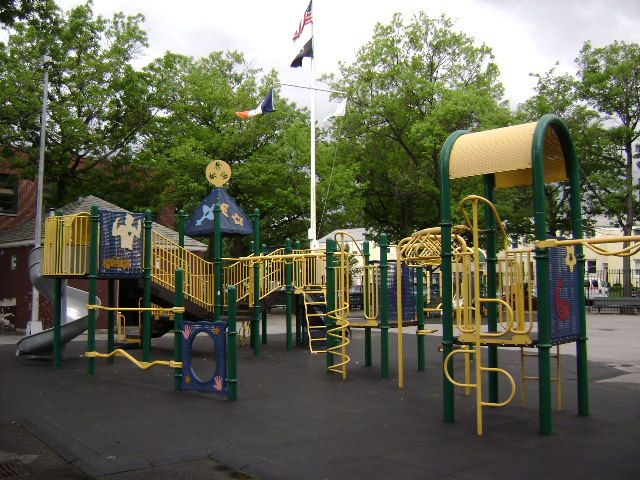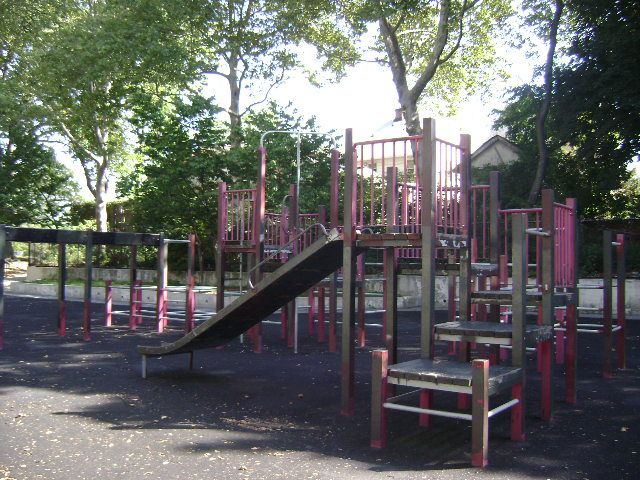-
“The Triborough Bridge is not merely a road for automobiles and trucks, but a general city improvement, reclaiming dead area and providing for residence along its borders, esplanades, play facilities, landscaping and access to great new parks.” -Robert Moses, 1936 This park honors the memory of Peter Chappetto, an Astoria resident who was killed in action during World War II. Read more...
-
Cedar Grove Playground, located just east of Cedar Grove Cemetery, is sandwiched between the City University of New York School of Law and J.H.S. 218 in Flushing, Queens. The cemetery is named for a group of cedar trees that once marked the graves of several men and women who died around the time of the American Revolution (1775-1783). In colonial Read more...
-
Castlewood Playground lies adjacent to P.S. 186 in the Queens neighborhood of Glen Oaks. A rural neighborhood for a long time, Glen Oaks was developed in the early part of the 20th century. Originally settled as farmland in the 1640s, the area retained its largely rural character until 1923, when a 167-acre plot of land was purchased from the nearby Read more...
-
Completed in 1971, the two pools on this site were designed by Heery/Heery and Associates, and built by Petracca & Sons Inc. at a cost of $641,300. The first is 60 feet wide, 75 feet long, and 3 1/2 feet deep and can accommodate up to 750 people at a time. The smaller “kiddie pool” is a 24 foot square Read more...
-
Captain George H. Tilly Park is named for a local son of a prominent Jamaica family, who was killed while fighting in the American subjugation of the Philippines in 1899. By provision of the Treaty of Paris in 1899, the United States annexed the Philippine Islands, a former Spanish colony, as a prize for its victory over Spain in the Read more...
-
Yellowstone Municipal Park rests between Yellowstone Boulevard, 68th Avenue, and 68th Road. Initially, the vacant land was partially owned by the Carol Management Corporation and the Cord Meyer Development Corporation, with plans for an apartment project. The site was acquired by condemnation on February 3, 1964. City Council Member Arthur Katzman initiated the development of the park, and the site Read more...
-
Although handball is one of the most popular games in the city and has long been identified with New York, depictions of hand-played ball games have been discovered in Egyptian tombs dated to 2000 BC, and in Arizona and Nicaragua, dated to 1500 BC. Not only a historic artifact, handball has its place in literature; Homer’s The Odyssey describes a Read more...
-
This area was once a 42-acre tract of farmland owned by the Haubitzer family. In 1899 the National Pigeon Shooters Association bought the property and built a grandstand and casino on the site, calling it Interstate Park. The largest annual trapshooting competition, the Grand American, took place here from 1900 to 1902, but attendance at the yearly event declined as Read more...
-
H. Jacob “Jack” Breininger (1894-1979), a local figure who devoted much time and effort to the betterment of his community, lived on nearby Lyman Street. Breininger created the Creedmoor Civic Association, which he presided over from 1936 until 1963, to raise awareness of local issues. He also served as a delegate to the 105th Precinct Community Council and to the Read more...
-
Briarwood Playground is named for the Queens neighborhood in which it is located. Bounded by Union Turnpike, Parsons Boulevard, Hillside Avenue, and the Van Wyck Expressway, Briarwood was developed by Herbert A. O’Brien in 1905. O’Brien was the owner of the Briarwood Land Company, which got its name through the suggestion of O’Brien’s wife, Adeline, who noted the woods and Read more...










